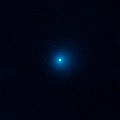File:Distant active comet C 2017 K2.jpg

本预览的尺寸:600 × 600像素。 其他分辨率:240 × 240像素 | 480 × 480像素 | 1,000 × 1,000像素。
原始文件 (1,000 × 1,000像素,文件大小:447 KB,MIME类型:image/jpeg)
摘要
| 描述Distant active comet C 2017 K2.jpg |
English: This Hubble Space Telescope image shows a fuzzy cloud of dust, called a coma, surrounding the comet C/2017 K2 PANSTARRS (K2), the farthest active comet ever observed entering the solar system. Hubble snapped images of K2 when the frozen visitor was over 2.4 billion kilometres from the Sun, just beyond Saturn's orbit. Even at that remote distance, sunlight is warming the frigid comet, producing a 128,000-kilometre-wide coma that envelops a tiny, solid nucleus. K2 has been traveling for millions of years from its home in the Oort Cloud, a spherical region at the edge of our solar system. This frigid area contains hundreds of billions of comets, the icy leftovers from the formation of the solar system 4.6 billion years ago. The image was taken in June 2017 by Hubble's Wide Field Camera 3. Links: NASA Press Release Schematic of comet C/2017 K2's approach to the Solar System |
| 日期 | |
| 来源 | https://www.spacetelescope.org/images/opo1740a/ |
| 作者 | NASA, ESA, and D. Jewitt (UCLA) |
许可协议
| ESA/Hubble images, videos and web texts are released by the ESA under the Creative Commons Attribution 4.0 International license and may on a non-exclusive basis be reproduced without fee provided they are clearly and visibly credited. Detailed conditions are below; see the ESA copyright statement for full information. For images created by NASA or on the hubblesite.org website, or for ESA/Hubble images on the esahubble.org site before 2009, use the {{PD-Hubble}} tag.
Conditions:
Notes:
|
说明
添加一行文字以描述该文件所表现的内容
此文件中描述的项目
描绘内容
2 10 2017
文件历史
点击某个日期/时间查看对应时刻的文件。
| 日期/时间 | 缩略图 | 大小 | 用户 | 备注 | |
|---|---|---|---|---|---|
| 当前 | 2019年12月31日 (二) 09:09 |  | 1,000 × 1,000(447 KB) | BevinKacon | actual size from source |
| 2017年10月3日 (二) 13:10 |  | 1,280 × 1,280(269 KB) | Jmencisom | User created page with UploadWizard |
文件用途
以下页面使用本文件:
全域文件用途
以下其他wiki使用此文件:
- ar.wikipedia.org上的用途
- en.wikipedia.org上的用途
- it.wikipedia.org上的用途
- ru.wikipedia.org上的用途
- uk.wikipedia.org上的用途
- www.wikidata.org上的用途
元数据
此文件含有额外信息,这些信息可能是创建或数字化该文件时使用的数码相机或扫描仪所添加的。如果文件已从其原始状态修改,某些详细信息可能无法完全反映修改后的文件。
| 图像标题 |
|
|---|---|
| 提供者 | NASA, ESA, and D. Jewitt (UCLA) |
| 来源 | ESA/Hubble |
| 简短标题 |
|
| 使用条款 |
|
| 数据生成日期时间 | 2017年10月2日 (一) 12:28 |
| JPEG文件备注 | This Hubble Space Telescope image shows a fuzzy cloud of dust, called a coma, surrounding the comet C/2017 K2 Pan-STARRS (K2), the farthest active comet ever observed entering the solar system. Hubble snapped images of K2 when the frozen visitor was 1.5 billion miles from the Sun, just beyond Saturn's orbit. Even at that remote distance, sunlight is warming the frigid comet, producing an 80,000-mile-wide coma that envelops a tiny, solid nucleus. K2 has been traveling for millions of years from its home in the Oort Cloud, a spherical region at the edge of our solar system. This frigid area contains at least 100 million comets, the icy leftovers from the formation of the solar system 4.6 billion years ago. During the comet's inward journey, gravitational tugs from the planets nudged it from its trajectory so that it is no longer gravitationally bound to the Sun. After K2 makes its closest approach to the Sun in 2022, it will leave the solar system forever. The image was taken in June 2017 by Hubble's Wide Field Camera 3. |
| 关键词 | C/2017 K2 PANSTARRS |
| 联系信息 |
Karl-Schwarzschild-Strasse 2 Garching bei München, None, D-85748 Germany |
| IIM版本 | 4 |


